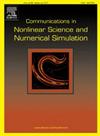具有网络攻击的Takagi-Sugeno模糊混沌马尔可夫跳跃系统的主动攻击补偿器控制
IF 3.4
2区 数学
Q1 MATHEMATICS, APPLIED
Communications in Nonlinear Science and Numerical Simulation
Pub Date : 2025-06-11
DOI:10.1016/j.cnsns.2025.109000
引用次数: 0
摘要
本研究主要探讨Takagi-Sugeno模糊混沌马尔可夫跳变系统在网络攻击、增益波动和外部干扰下的攻击重建和基于攻击补偿器的非脆弱控制问题。首先,构建一个中间变量,作为构建中间观测器的基础,该观测器同时估计系统状态并重构网络攻击。在此基础上,提出了一种抗攻击的非脆弱控制机制,有助于减轻系统中的网络攻击。同时,外部干扰对系统的不利影响通过耗散性能被抵消。在此基础上,以线性矩阵不等式的形式给出了保证系统预期有界性的新充分条件。最后,提供了具有模拟结果的数值例子来证明所开发的理论见解的效力。本文章由计算机程序翻译,如有差异,请以英文原文为准。
Active attack compensator control for Takagi–Sugeno fuzzy chaotic Markovian jump systems with cyber attacks
The prime focus of this study is to explore the attack reconstruction and attack-compensator-based nonfragile control issues of the Takagi–Sugeno fuzzy chaotic Markovian jump systems in the midst of cyber attacks, gain fluctuations and external disturbances. Firstly, an intermediate variable is framed, which serves as the basis for the construction of an intermediate observer that concurrently estimates the state of the system and reconstruct the cyber attacks. Subsequently, a attack-tolerant nonfragile control mechanism is developed, which aids in mitigating the cyber attacks in the system. Meanwhile, the detrimental effects of external disruptions on the system are offset via dissipative performance. From thereon, novel sufficient conditions ensuring the intended boundedness of the assayed system are framed in the form of linear matrix inequalities. Ultimately, numerical examples with simulation results are offered to demonstrate the potency of the developed theoretical insights.
求助全文
通过发布文献求助,成功后即可免费获取论文全文。
去求助
来源期刊

Communications in Nonlinear Science and Numerical Simulation
MATHEMATICS, APPLIED-MATHEMATICS, INTERDISCIPLINARY APPLICATIONS
CiteScore
6.80
自引率
7.70%
发文量
378
审稿时长
78 days
期刊介绍:
The journal publishes original research findings on experimental observation, mathematical modeling, theoretical analysis and numerical simulation, for more accurate description, better prediction or novel application, of nonlinear phenomena in science and engineering. It offers a venue for researchers to make rapid exchange of ideas and techniques in nonlinear science and complexity.
The submission of manuscripts with cross-disciplinary approaches in nonlinear science and complexity is particularly encouraged.
Topics of interest:
Nonlinear differential or delay equations, Lie group analysis and asymptotic methods, Discontinuous systems, Fractals, Fractional calculus and dynamics, Nonlinear effects in quantum mechanics, Nonlinear stochastic processes, Experimental nonlinear science, Time-series and signal analysis, Computational methods and simulations in nonlinear science and engineering, Control of dynamical systems, Synchronization, Lyapunov analysis, High-dimensional chaos and turbulence, Chaos in Hamiltonian systems, Integrable systems and solitons, Collective behavior in many-body systems, Biological physics and networks, Nonlinear mechanical systems, Complex systems and complexity.
No length limitation for contributions is set, but only concisely written manuscripts are published. Brief papers are published on the basis of Rapid Communications. Discussions of previously published papers are welcome.
 求助内容:
求助内容: 应助结果提醒方式:
应助结果提醒方式:


